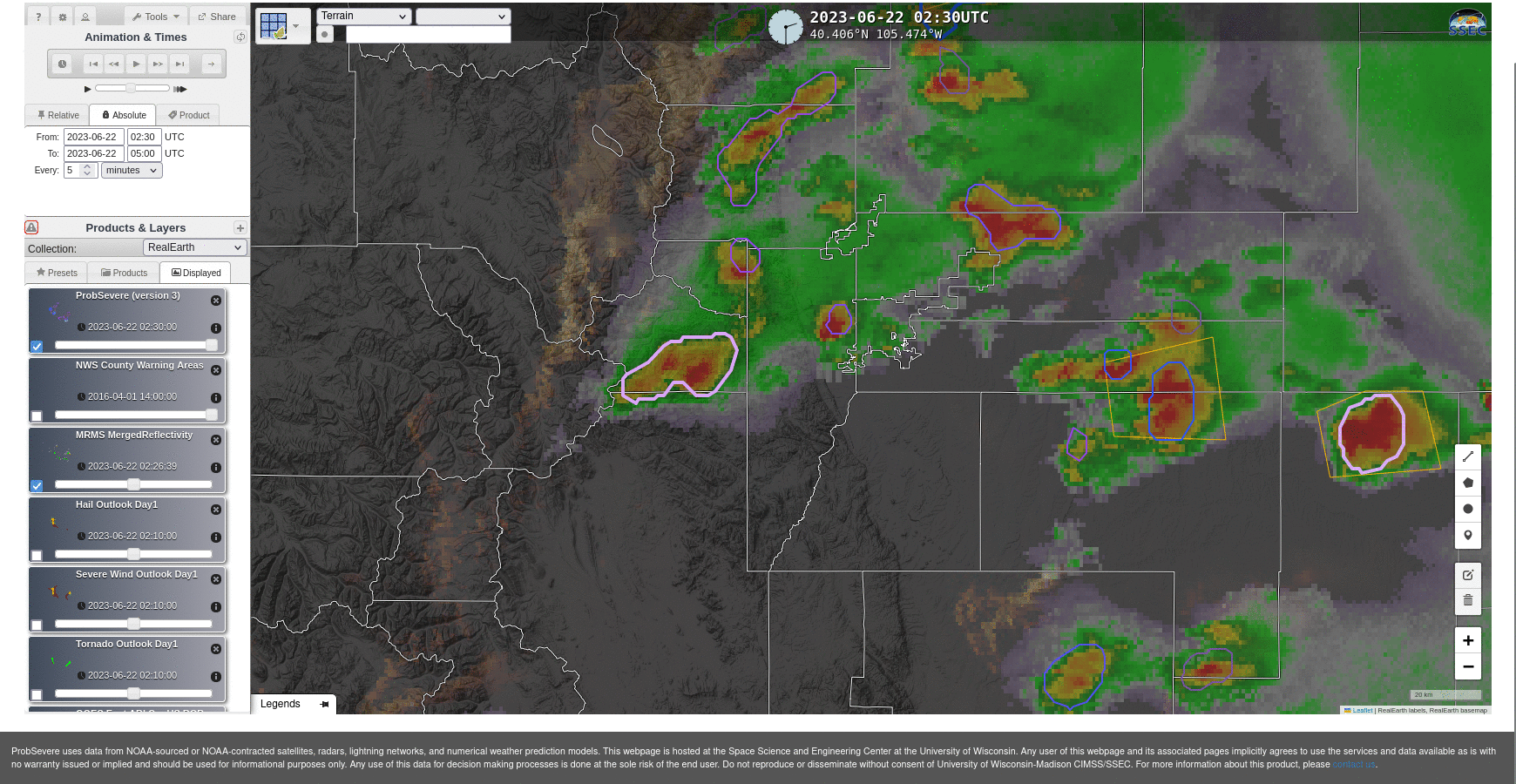
[ Archive ]

 |
CIMSS-NOAA Weekly Report [ Archive ] |
 |
CIMSS AND ASPB WEEKLY HIGHLIGHTS FOR THE WEEK ENDING JUNE 23, 2023
DATA, INFORMATION, AND USE-INSPIRED SCIENCE:
UW/SSEC Data Services Supporting EWS-G1 Testing: To support both the initiation of XGOHI (eXtended GOes High Inclination operations - remapping the imagery before GVAR generation), as well as special (more rapid) scan modes on the EWS-G1 (Electro-optical Infrared Weather System Geostationary), the University of Wisconsin Space Science and Engineering Center (SSEC) Data Services modified their realtime display system. Before being transferred to the Space Force, EWS-G1 was GOES-13 (launched in 2006). Starting XGOHI (to account for larger satellite inclination), improved image quality. Feedback from the operational satellite engineers: "We appreciate your receipt and display of EWS-G1 data." More on XGOHI when it was employed on GOES-10 and -12: https://journals.ametsoc.org/view/journals/bams/99/1/bams-d-16-0029.1.xml. (T. Schmit, E/RA2, 608-263-0291, tim.j.schmit@noaa.gov; UW/SSEC Data Services)
(Click image to enlarge)
Figure: A EWS-G1 (formerly GOES-13) band 3 (6.7 micrometer) "water vapor" image at a high satellite inclination time before (left) and after (right) XGOHI was initiated.
FUTURE OUTLOOK:
AWARDS AND RECOGNITION:
TRAVEL AND MEETINGS:
WMO Global Cryosphere Watch Meetings on Requirements and Best Practices: The World Meteorological Organization (WMO) Global Cryosphere Watch (GCW) program held two meetings in Geneva, Switzerland, 12-15 June 2023. The first meeting, organized and run by Jeff Key (STAR), was to continue work on the enumeration of observing requirements for sea ice, the identification of gaps in the sea ice observing system, and to begin writing a Statement of Guidance for WMO Members that will serve as a guide on recommendations to fill the observing system gaps. The second meeting was to begin writing a chapter on sea ice observing best practices (how to make the measurements) for the WMO Technical Regulations. (J. Key, E/RA2, 608-263-2605, jeff.key@noaa.gov)
TRAINING AND EDUCATION:
CIMSS participation in WMO Center of Excellence training: William Straka was a trainer for a course on "Training the trainer for Satelite-derived Flood products and it's implementation in Impact Based Forecast (IBF) and Warning Services at the Badan Meteorologi, Klimatologi, dan Geofisika (BMKG, Indonesian Met service) World Meteorological Organization (WMO) Regional Training Center. The course ran from 19-23 June 2023 (UTC time) where over 40 participants from agencies from several countries, including Indonesia, Philippines, Cameroon, Oman, Canary Islands and several other countries came together to learn about the NOAA Flood products and how they could be used in Impact Based Forecasting, which is part of the WMO initiative for "Early Warnings for All". The course included presentations, discussions as well as a hands on demonstration and a graded homework assignment. By the end, not only did the participants know how to use the products, they were able to successfully utilize the tools in a case study which was presented in the closing discussion. This training also fostered many interactions for future collaboration. (W. Straka III, CIMSS)
VISIT teletraining on LightningCast Probabilities: Scott Lindstrom from the Cooperative Institute for Meteorological Satellite Studies (CIMSS) gave a Virtual Institute for Satellite Integration Training (VISIT) presentation on LightningCast Probabilities to the Science and Operation Officer (SOO) and a Lead Forecaster at the National Weather Service Forecast Office in the Quad Cities (IA/IL), i.e., WFO DVN. The 20-minute presentation discussed the product and its uses, particularly in Decision Support, and was followed by discussion. (S. Lindstrom, CIMSS, 608 263 4425)
MEDIA INTERACTIONS AND REQUESTS:
SOCIAL MEDIA AND BLOG Posts:
SSEC and CIMSS Scientists in the News: Scientists at the University of Wisconsin-Madison (UW) Space Science and Engineering Center (SSEC) and the Cooperative Institute for Meteorological Satellite Studies (CIMSS) provide expert interviews, imagery and case studies to promote science. This week: CIMSS Satellite Blog contributors Scott Lindstrom and Scott Bachmeier published these case studies: “ProbSevere with Large Hail at a Red Rocks Amphitheater Concert” (June 22, 2023), "Large hail at a Red Rocks concert in Colorado, viewed using GOES-16 and GOES-18" (June 21, 2023), "How fast can you create JPSS imagery from data on the Amazon Cloud using Polar2Grid?" (June 21, 2023), "Tropical Storm Bret" (June 19, 2023), "Pyrocumulonimbus cloud produced by the Pulp Road Fire in North Carolina" (June 16, 2023), "Perryton, Texas tornado" (June 15, 2023). Read more at the CIMSS Satellite Blog: https://cimss.ssec.wisc.edu/satellite-blog/. (S. Lindstrom, CIMSS, S. Bachmeier, CIMSS, E. Verbeten, SSEC)
 (Click image to enlarge)
(Click image to enlarge)
Figure: The animation shows the RealEarth display of ProbSevere (version 3) and it shows the approach of the radar object that produced the hail; a severe thunderstorm warning was in place. Hail has much larger probabilities than either wind or tornado in this case. Maximum Expected Hail Size at 0330 UTC was 2.46″.
PUBLICATIONS:
OTHER:
| Archived Weeklies Page | Submit a report item |